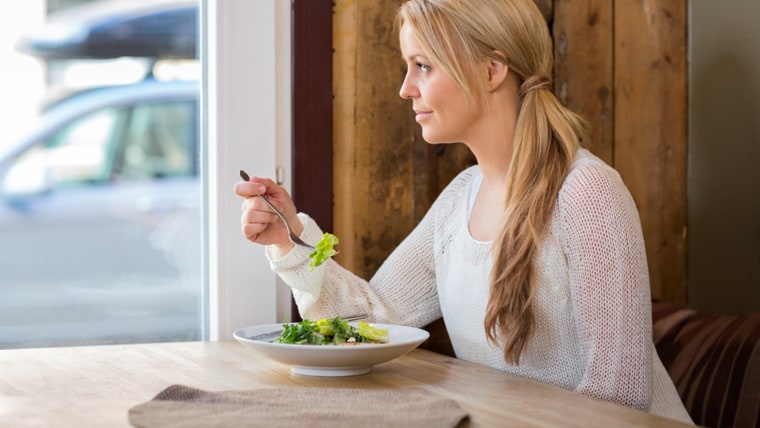When it comes to meal time, the perfect theme music for many Americans might be “All By Myself.”
Shifts in family structures and our rushed, modern schedules are having a strong impact on how we consume meals. Almost half — or 46 percent — of all eating occasions in the U.S. now consist of a person eating alone, according to a recent report published by the Food Marketing Institute.
Solo diners are also responsible for the jump in snack foods being consumed at meal times, The NPD Group, a market research company, announced this month. Some 48 percent of adults now replace meals with snacks at least three times a week.
Breakfast is the most common meal we eat solo — with 61 percent of us scarfing our grab-and-go morning meals alone — followed by lunch (55 percent) and dinner (34 percent), previous research from the NPD Group has found.

“These kinds of reports reflect the changing attitude about food and time management. The idea that the act of eating is consuming food as fuel… and not a social platform,” said TODAY Health and Nutrition Editor Madelyn Fernstrom.
“Time is a big factor and gone are the two-martini lunches, or even hour long lunches with a friend to catch up. We have many ways — with social media — to stay in touch, and mealtime doesn’t need to fulfill this role.”
From a nutrition standpoint, that’s not necessarily a bad thing even as eating alone — especially in public — still makes many of us uncomfortable.
Studies show that when people eat together, they typically eat more, Fernstrom noted. One reason is that they may be paying less attention to body signals that let them know when they’re full. There’s also typically less willpower with a group, with peer pressure contributing to diners ordering more food.
Meanwhile, eating alone is often a more mindful experience, with people paying more attention to what they choose, and how they are eating, Fernstrom said.
Read more: Eat your veggies, America: A government report shows a gap in many people's diets
Nutritionist Bonnie Taub-Dix agrees that eating alone gives her the chance to think and appreciate her food, but she worries that many solo diners pay more attention to their gadgets or the TV screen rather than their meals, missing out on the flavor and texture of food.
“I don’t think people are really alone, alone. They’re alone with their phones and alone with their computers,” said Taub-Dix, R.D., author of “Read It Before You Eat It.”
"People do a lot of dashboard dining, eating in their car; a lot of desktop dining, eating at our desks... A lot of people are not taking the time to go and eat."
Taub-Dix also noted some people may feel they’re more at liberty to eat whatever they want, how much they want, when there's no one else around. And she's passionate about encouraging families to eat together.
Read more: Kitchen makeover: 8 small changes to help you lose weight
Fernstrom offered these tips for solo diners:
- Eat slowly and don’t wolf down a meal. Take at least 15-20 minutes to eat. That’s best for digestion and to allow signals from your stomach to reach your brain to help gauge fullness and avoid overeating.
- Be a mindful eater and order smartly. You’re eating for one, but most single servings in restaurants are enough for at least two people. Eat half and take the rest home, or leave it behind.
- Enhance your eating experience with something you enjoy, if you're not a fan of the quiet time. But don't make it about work. Rather, read a magazine or book, listen to music, or catch up on fun social media.
- Don’t avoid social contact for all meals. Food is also part of life’s enjoyments and breaking bread together is a bonding experience.